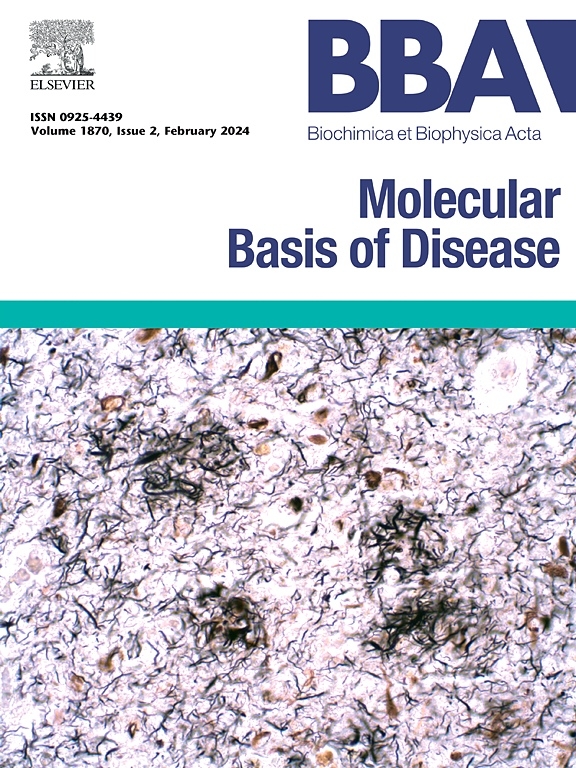亨廷顿蛋白N17区的翻译后修饰:对自结合和膜结合的影响
IF 4.2
2区 生物学
Q2 BIOCHEMISTRY & MOLECULAR BIOLOGY
Biochimica et biophysica acta. Molecular basis of disease
Pub Date : 2025-08-18
DOI:10.1016/j.bbadis.2025.168019
引用次数: 0
摘要
亨廷顿氏病是一种神经退行性疾病,与亨廷顿蛋白第一个外显子(HTT外显子1)内的聚谷氨酰胺扩增有关。这种突变导致HTT功能障碍和n端HTT聚集体的产生。通过前17个残基(N17)的自结合,HTT外显子1片段的二聚化被认为是HTT外显子1聚集途径的第一步。N17与膜的结合被认为通过增加外显子1的局部浓度来催化聚集,并且已知N17的翻译后修饰(PTMs)会影响膜的相互作用和外显子1的聚集速率。为了阐明N17 PTMs对自结合和膜相互作用的影响,从而深入了解HTT功能和外显子1聚集,我们使用溶液核磁共振和圆二色光谱来分析初始蛋氨酸的损失、随后的乙酰化、苏氨酸和丝氨酸的磷酸化。我们的研究结果表明,N17的修饰增强了螺旋度,从而增加了自结合和膜相互作用。然后,我们进行了x射线晶体学研究,得出了与N17二聚体关联一致的HTT外显子1二聚化模型。这有助于深入了解ptm对HTT聚合的影响。我们所描述的实验方法和N17自关联模型可以为进一步实验探索N17 PTMs对HTT功能和致病性的影响奠定基础。本文章由计算机程序翻译,如有差异,请以英文原文为准。
Post-translational modifications of huntingtin's N17 region: implications for self-association and membrane binding
Huntington's disease is a neurodegenerative disorder associated with a polyglutamine expansion within the first exon of the huntingtin protein (HTT exon 1). This mutation results in HTT dysfunction and the production of N-terminal HTT aggregates. The dimerization of the HTT exon 1 fragment through self-association of the first 17 residues (N17) is considered the initial step in the HTT exon 1 aggregation pathway. The association of N17 with membranes has been proposed to catalyze aggregation by increasing the local concentration of exon 1, and post-translational modifications (PTMs) in N17 are known to influence membrane interaction and the aggregation rate of exon 1. To elucidate the influence of N17 PTMs on both self-association and membrane interaction, thereby gaining insight into HTT function and exon 1 aggregation, we used solution nuclear magnetic resonance and circular dichroism spectroscopies to address loss of initial methionine, subsequent acetylation, and phosphorylation of threonine and serines. Our findings indicate that modifications to N17 that enhance helicity correspond to increased self-association and membrane interaction. We then conducted X-ray crystallographic studies that led to a proposed HTT exon 1 dimerization model consistent with the association of N17 dimers. This provides insight into the impact of PTMs on HTT aggregation. The experimental methods and N17 self-association model we describe may serve as a foundation for further experiments exploring the influence of N17 PTMs on HTT function and pathogenicity.
求助全文
通过发布文献求助,成功后即可免费获取论文全文。
去求助
来源期刊
CiteScore
12.30
自引率
0.00%
发文量
218
审稿时长
32 days
期刊介绍:
BBA Molecular Basis of Disease addresses the biochemistry and molecular genetics of disease processes and models of human disease. This journal covers aspects of aging, cancer, metabolic-, neurological-, and immunological-based disease. Manuscripts focused on using animal models to elucidate biochemical and mechanistic insight in each of these conditions, are particularly encouraged. Manuscripts should emphasize the underlying mechanisms of disease pathways and provide novel contributions to the understanding and/or treatment of these disorders. Highly descriptive and method development submissions may be declined without full review. The submission of uninvited reviews to BBA - Molecular Basis of Disease is strongly discouraged, and any such uninvited review should be accompanied by a coverletter outlining the compelling reasons why the review should be considered.

 求助内容:
求助内容: 应助结果提醒方式:
应助结果提醒方式:


